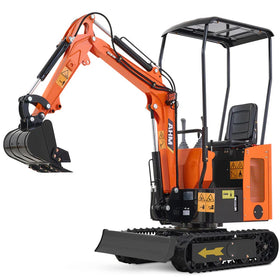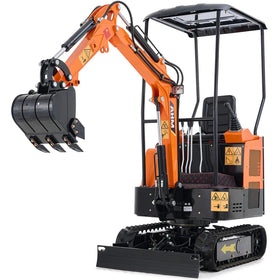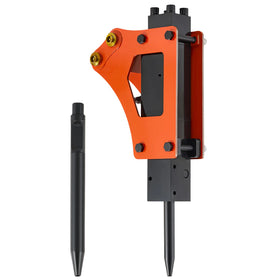When you break concrete, you're essentially creating controlled cracks that let you remove manageable pieces.
That solid slab in your yard isn't just a simple piece of concrete. Most residential concrete is 4-6 inches thick and often contains hidden metal reinforcement that prevents clean breaks.
The ground underneath plays a huge role too. Without proper technique, the soil absorbs most of your breaking force, making you work much harder than necessary.
1. Manual Breaking: Best for Small, Thin Slabs

Manual breaking works well for thin concrete under 4 inches with no reinforcement.
How to Break Up Concrete Manually
Create a working edge first. Find a corner or crack, then dig out about 6 inches of soil underneath. This creates a "void" that gives concrete room to break instead of absorbing your hammer strikes.
Position your sledgehammer correctly. Place one hand near the head and the other at the base. Instead of wild swings, lift the hammer straight up and let gravity do the work.
Work in a grid pattern. Space your strikes about 12 inches apart to create a network of cracks. Once cracks form, use your pry bar to separate pieces into manageable 2-foot sections.
Reality check: Even a small 10×10 foot patio typically takes two full days of intense physical work using this method.
2. Power Tools: Perfect for Medium Projects

Electric jackhammers can significantly boost your breaking power while remaining manageable.
How to Break Up Concrete With A Jackhammer
Mark your breaking area into 2-foot sections before starting. Position yourself with feet shoulder-width apart and hold the jackhammer at a slight 15-degree angle.
Let the tool's weight work for you. Start at one end of your marked line and slowly walk backward as you break. You'll feel when the bit breaks through—that's when to move a few inches back.
Make smaller grid patterns (about 12 inches square) for reinforced concrete. Keep bolt cutters handy for snipping exposed wire mesh.
This method balances effort with effectiveness. It works well for medium-sized projects like sidewalk sections or small patios.
3. Mini Excavator

For larger areas or reinforced concrete over 4 inches thick, equipment like mini excavators with hydraulic breakers becomes necessary.
How to Break Up Concrete With A Mini Digger
Position your machine correctly. Place the excavator at a 90-degree angle to your starting edge with tracks parallel to the work face for maximum stability.
Maintain consistent pressure. Start with your breaker point about 3 inches from the slab's edge. Apply steady pressure for 15-20 seconds per spot before moving.
Work systematically in lanes. Move in sections about the width of your breaker, using your machine's bucket to clear debris as you go.
Speed difference is dramatic. That same 10×10 foot patio that took two days by hand? A mini excavator handles it in about an hour.
These mini diggers can break up concrete 20-30 times faster than manual methods.
That same 10x10 foot patio that took two days by hand, a mini excavator can handle it in about an hour.
Checklist When Breaking Up Concrete

Before you commit to any breaking method, here's what you need to check:
✓ Concrete thickness: Measure an exposed edge. Anything over 4 inches usually requires power tools or equipment.
✓ Hidden reinforcement: Look for metal in existing cracks. Reinforcement significantly increases breaking difficulty.
✓ Underground utilities: Always call 811 for utility marking before breaking. Hitting a power line or water pipe creates dangerous emergencies.
Safety Requirements You Can't Ignore

Breaking concrete creates flying debris and dust, so proper protection isn't optional. You'll need:
- Safety glasses to protect your eyes from concrete chips
- A dust mask rated for concrete dust (a regular dust mask isn't enough)
- Steel-toed boots to protect your feet from falling pieces
- Heavy work gloves to prevent blisters and cuts
- Ear protection when using power tools or equipment
Beyond personal protection, you need to shield your work area.
Cover nearby windows and siding with plywood or heavy plastic sheeting.
Concrete chunks can fly surprisingly far when breaking, especially with power tools or equipment.
What About Broken Concrete Removal

Here's something many people don't consider until they're halfway through their project: broken concrete is heavy and most regular trash services won't take it.
A typical cubic yard of concrete weighs about 2 tons. For perspective, that's roughly what you'd get from breaking up a 20x20 foot patio.
Your disposal options include:
- Renting a roll-off dumpster specifically rated for concrete
- Hauling it to a construction waste facility yourself (though this usually means multiple trips)
- Hiring a specialized removal service
- Repurposing smaller pieces for other projects like garden borders or retaining walls
Mini Excavators Make Concrete Removal Easy
When your project exceeds what manual tools can handle, mini excavators with hydraulic breakers offer significant advantages.
These compact excavators bring consistent breaking power without operator fatigue. A hydraulic breaker delivers the same force on its hundredth strike as its first - something no human with a sledgehammer can match.
AHM AX-16C Mini excavators with swing boom can handle confined spaces thanks to zero-tail swing designs and compact dimensions. Many units can fit through a standard backyard gate while still packing enough power to break reinforced concrete effectively.
Common Questions About Breaking Up Concrete
How long does it take to break up concrete?
Breaking time varies based on your method and concrete characteristics:
- Manual breaking (10×10 foot patio): 16-20 hours over multiple days
- Power tools: 6-8 hours for the same area
- Mini excavator: 1-2 hours for complete removal
What's the best way to break concrete without damaging what's underneath?
Create a "relief cut" by digging slightly under the slab's edge or lifting sections with a pry bar as you break. This technique works with any breaking method and helps prevent damage to underlying surfaces.
How thick of concrete can different tools handle?
- Manual tools (sledgehammer/pry bar): Up to 4 inches of unreinforced concrete
- Electric jackhammer: Up to 6 inches, including light reinforcement
- Mini excavator with breaker: 8+ inches, including heavy reinforcement
Is concrete removal a DIY project?
This depends entirely on your project's scope and the concrete's characteristics.
Small, unreinforced slabs under 4 inches thick can be DIY projects if you're physically capable. However, larger areas, reinforced concrete, or thicker slabs usually require professional equipment.
How do I know if my concrete is reinforced?
Check existing cracks or edges for metal bars or wire mesh. You can also tap the surface with a hammer—reinforced concrete typically produces a sharper, more metallic sound.
Conclusion
Here's where thinking bigger can actually save you money in the long run. A mini excavator can do much more than breaking up concrete – it's a versatile tool that transforms how you manage your property. The same machine that efficiently breaks up your old patio can also:
- Grade your land for better drainage
- Dig trenches for irrigation systems
- Clear brush and small trees
- Create garden beds and landscaping features
- Handle snow removal in winter months
Looking Beyond Concrete Removal
Think about your property's long-term needs. Many of our readers who initially looked into concrete removal discovered that investing in versatile equipment opened up possibilities they hadn't considered.
From creating perfect drainage solutions to establishing elaborate landscaping features, the right equipment turns challenging property projects into achievable goals.
Want to explore more ways to maximize your property's potential? Check out our guides on:







